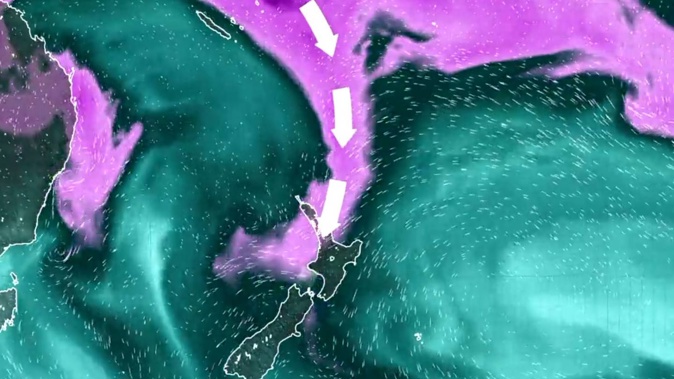
They’ve driven some of our most damaging deluges: now scientists have gained a clearer idea just what influence moisture-packed ”atmospheric rivers“ have on our normal rainfall.
Capable of carrying double the average flow of the Amazon River – and snaking thousands of kilometres between the tropics and the mid-latitudes – about 40 of these long, thin filaments of moisture typically make landfall in New Zealand each year.
Although they’re most common in the southwest - and typically turn up as stronger events over warmer months - atmospheric rivers could still hit anywhere, at any time.
That was something dramatically highlighted by a slew of systems that have hit around the country – including one that put swathes of Canterbury farmland underwater in mid-2021 - throughout three abnormally warm and wet years under La Nina.
In a new study, scientists looked back over more than half a century of data to get a better picture of how important these systems were for our monthly rainfall.
Drawing on nearly daily records from nearly 530 rain gauges, the study team grouped data spanning between 1950 and 2020 into wet, normal and dry months.
They then used an automated algorithm to identify atmospheric rivers over that period, before calculating the fraction of monthly rainfall sourced from them to tease out their overall influence in different times and geographic areas.
Their findings showed that, for most sites in the northern and western North Island, and especially during the warm season, atmospheric rivers contributed to more than half of monthly rainfall.
By contrast, for most eastern areas, they weren’t found to deliver higher monthly totals than unrelated rainfall events, which were instead shown to largely make up rainfall availability in these regions.
Study co-author Associate Professor Asaad Shamseldin, of the University of Auckland, said it wasn’t surprising to see the systems have such a large influence on monthly rainfall in New Zealand’s north, and on the western side of its mountain terrain.
/cloudfront-ap-southeast-2.images.arcpublishing.com/nzme/GT7VJPTHNHWKLMPJYMRJOBMFLE.jpg)
Atmospheric rivers - like one that caused a costly flood in Westport in 2021 - are more common in New Zealand's southwest and north. Photo / George Heard
Because they tended to move northwesterly, the intensity of those atmospheric rivers making landfall in the warm season was also higher than in cooler months.
Looking ahead, he said these new insights could help inform drought forecasts, especially for those western and northern regions over warmer times of the year.
As climate change brought major shifts, there was also the potential to better inform how reservoirs were operated.
“Integrating knowledge into rainfall forecasts from daily to monthly can potentially improve water supply reliability, flood control and drought mitigation.”
The new findings, released online ahead of peer review, come after an Otago University-led analysis concluded atmospheric rivers which affected the south were different beasts to those in the north.
For the north, moisture coming from the subtropical Tasman Sea is the most important, whereas in the the south, the main driver of atmospheric rivers is the strength of the westerly winds across the Southern Ocean.
It also explored links to climate change, finding there were some general patterns we could draw.
One was westerly winds shifting further southward – something that’s already been caused by ozone depletion over Antarctica – which would in turn shift the location of high and low-pressure systems in our atmosphere.
Another was the fact that each additional degree of global warming meant the atmosphere could hold more moisture – something that could pack more power into future atmospheric rivers.
National Institute of Water and Atmospheric Research (Niwa) meteorologist Ben Noll said that our recent period of La Nina, culminating in the north’s wettest summer in recorded history, underscored the importance of understanding that risk.
“There’s no doubt that the last year, especially, has brought a profound amount of atmospheric rivers,” he said.
“As seas warm up, and the moisture-holding capacity of the air increases, what these systems look like now and in future is ever-pertinent for New Zealand’s climate.
“I also think it’d be advantageous to think about some form of early warning system for atmospheric rivers: that would benefit us [in the] future, because these things aren’t going to be going away.”
Take your Radio, Podcasts and Music with you









